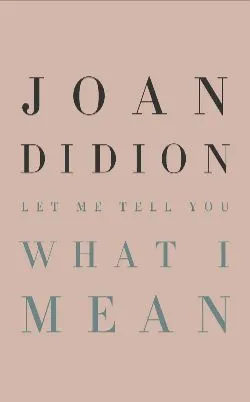
The essays in this book begin with an insane first line:
The only American newspapers that do not leave me in the grip of a profound physical conviction that the oxygen has been cut off from my brain tissue, very probably by an Associated Press wire, are The Wall Street Journal, the Los Angeles Free Press, the Los Angeles Open City, and the East Village Other.
Such is Joan Didion’s breathtaking literary ability.
I’ve never read any of Didion’s work before. If I’m not mistaken, she’s most famous for her novels, although her essays have gained a lot of traction too. Let Me Tell You What I Mean is her final collection, and it brings together essays from the late 1960s to 2000. These essays had existed in periodicals before, but never in a bundled volume like this one.
One of my first impressions is that Didion has been heavily influenced by Ernest Hemingway. I think “Hills Like White Elephants” has been especially important to her, and she mentions it in three or four of the essays. Even greater, there is an entire essay (“Last Words”) about Hemingway and his legacy. Didion’s essay is a response to a controversy about publishing one novel that Hemingway never wanted to be published. In 1999, Scribner decided to publish it. The essay itself is a delightful examination of literary legacy, privacy, and choices with regard to posthumous publication (another that should have never been published is Harper Lee’s Go Set a Watchman). She, of course, sides with Hemingway.
Another unexpected deep-dive is into Martha Stewart’s business (“Everywoman.com”). Unlike other commentators, who suggested that Stewart sold 1950s domesticity, Didion adroitly argues something quite different: Martha Stewart sells rough, ragged, American individualist can-do and competence. The point here is not that women can or should develop their kitchen/garden/household skills, Stewart’s aim is to foster a sense of “I can do things, too!” in women. While I have little love for Martha Stewart, it is impossible not to see her a bit differently after absorbing Didion’s interpretation. Her perception of Nancy Reagan, in “Pretty Nancy,” is the exact opposite.
I was especially fond of some of the more personal essays: “Why I Write,” for example, as well as “On Being Unchosen by the College of One’s Choice” and “Telling Stories.” They offer a glimpse into how Joan Didion the writer became who she is. Whether it was learning about how meaningful her instructor was to her, the way that working at Vogue made her think closely about lexical and syntactical choices, or the specific experiences that shaped her, these were really interesting chapters that I feel is necessary to learn from.
There is no expectation here that you get Didion’s work before stepping into this book; it’s a great introduction to the writing of a literary luminary, and I highly recommend it to those who are especially fond of the essay.